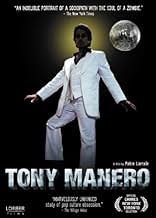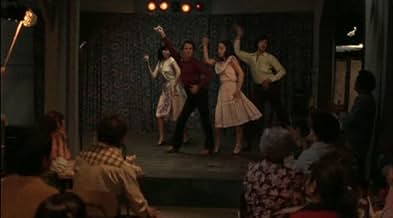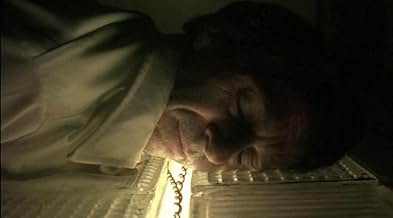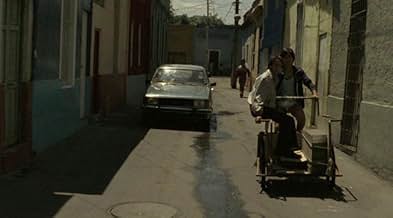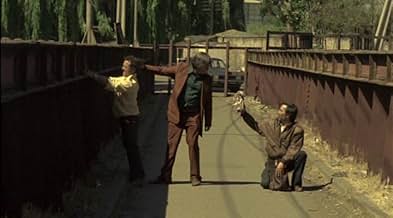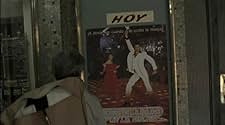AVALIAÇÃO DA IMDb
6,8/10
4,7 mil
SUA AVALIAÇÃO
Adicionar um enredo no seu idiomaA man is obsessed with John Travolta's disco dancing character from Os Embalos de Sábado à Noite (1977).A man is obsessed with John Travolta's disco dancing character from Os Embalos de Sábado à Noite (1977).A man is obsessed with John Travolta's disco dancing character from Os Embalos de Sábado à Noite (1977).
- Direção
- Roteiristas
- Artistas
- Prêmios
- 19 vitórias e 16 indicações no total
- Direção
- Roteiristas
- Elenco e equipe completos
- Produção, bilheteria e muito mais no IMDbPro
Avaliações em destaque
The film, which conveys impressions from a country that is politically and economically collapsed, shows us how martial law situations actually get people out of control psychologically and sociologically rather than creating a control mechanism. You are increasingly watching your character's obsessions about the role model of a psychopathic character and their relationship with other people.
This film has lingered in my mind for a very long time.
The lead character is probably one of the scariest and most disturbing I have seen on cinema . He is without any morality and empathy but for some reason you are captivated by him and his life. You want him to succeed at first but as the film progresses you ate repulsed by him but stills obtain a fascination in his life. This is due to the writing and directing.?
The conditions and larger political scope of the film are well thought out, to live in that kind of fascistic government one such as the lead of this film is created and thrives. He is the logical product of that environment.
The scene when he kills the old woman for the TV is so disturbing i still think about it to this day and I saw it about three years ago.
The most haunting aspect for me was when he gets on the bus at the end and watches the winner of the competition and we all know what will happen, what he will do and what is store for his prey. Brilliant ending.
This is brutal, disturbing and amazingly directed.
The lead character is probably one of the scariest and most disturbing I have seen on cinema . He is without any morality and empathy but for some reason you are captivated by him and his life. You want him to succeed at first but as the film progresses you ate repulsed by him but stills obtain a fascination in his life. This is due to the writing and directing.?
The conditions and larger political scope of the film are well thought out, to live in that kind of fascistic government one such as the lead of this film is created and thrives. He is the logical product of that environment.
The scene when he kills the old woman for the TV is so disturbing i still think about it to this day and I saw it about three years ago.
The most haunting aspect for me was when he gets on the bus at the end and watches the winner of the competition and we all know what will happen, what he will do and what is store for his prey. Brilliant ending.
This is brutal, disturbing and amazingly directed.
THis film sneaks up on you - there is something unsettling and powerful about it. The lead performance is raw, real and sad. This guy is a low street thief who has a circle of whores and other lowlifes around him. It doesn't matter if you know a bit about the horrible regime of General Pinochet who was in power when the film is set - 1978 but the movie is a metaphor for this brutal dictator's control of the country - insane behavior creating insane results. The lead guy is obsessed with Travolta's film Saturday Night Fever - he watches it in a movie theatre endlessly - memorizing the dialogue and all of Travolta's moves and dance steps. A Chile TV Variety show has celebrity look-a-like contests and he was to enter and win the Tony Manero contest - white suit and all. This movie feels like a documentary - and there are moments of calm followed by shocking displays of violence. I can see that this film might not be for everyone but I found it to be incredibly powerful. I disagree with the summary on this page though that describes the guy as a "serial killer" - he is not a serial killer - he just makes sure to get anyone out the way who stands between him and his obsession.
It is a very interesting Chilean film; it has a strange plot and the acting is good; it is a very bizarre experience.
If the name Tony Manero means anything to anyone at all, then it will be because of a rather famous breakthrough role on behalf of a certain American actor named John Travolta, whose performance as said character in 1977's Saturday Night Fever saw him propelled into the acting limelight as this fascinating negotiator of the dance floor and charismatic presence when dialogue and exchange was required. With the release of this, a hard boiled Chilean drama directed by a certain Pablo Larraín and arriving with it the title of Tony Manero, the name threatens to take on a new found sense of identity or initial 'link' with audiences; much like the musical number "Singing in the Rain" may have done with some once Kubrick got his hands on it. Very few films that I can recall have had the ability to have you symptomatically tapping your feet at a catchy tune accompanying the somewhat elated feeling brought about by the grace of an on screen dance performance, whilst forcing you to watch proceedings through the spindly cracks that formulate out of having all of your fingers pressed together due to not really being able to watch. This Chilean film about idolisation and the impact of Western culture on foreign lands is one of them; a fascinating, a positively nihilist, take on the daring to dream whilst under a proverbial strain and is a shattering experience.
For the most part, the film plays out like this really stripped down; really rather grotty look at poor Chileans living under the tyranny of the then Pinochet-led government of the early 1980s, that just so happens to encompass a bi-polar man who's on the cusp of psychopathy and has an obsession for Travolta's aforementioned character. At the core of it is lead Raúl Peralta (Castro); a man operating within certain circles encompassing family members and contacts down at the oft-frequented local dancing club, but a man with a dangerous obsession of both the titular character of years gone by and the film from whence he comes. Peralta cuts a worn, ominous figure; a man with the mannerisms and understated sense of both threat and anger to that of Travis Bickle, an accent with a chiselled complexion plus general sense of menace to that of Pacino's Scarface anti-hero lead Tony Montana. A peek into his mind reveals the uncontrollable desire to lash out at those unsuspecting and vulnerable, the beating to death of an elderly woman, whose company he briefly shares whilst in her home, giving way to an unfathomable sense of anguish seeing him eventually take measures to make sure that her now orphaned pet cat will not remain alone and therefore starve.
Peralta's dream is to dance professionally, this unfriendly; sleazy; whore dwelling lowlife whom, at one point, loots the body of a dead man because it benefits him, desires to branch off and find success within a practice often attributed with characteristics of prouesse, elegance and splendor. Thinking he's ready for the challenge, we observe him in the opening scenes attend a televised dance competition at a studio which sees him not only turn up on the incorrect date alluding to more dangerous issues there, but completely go against rules and regulation that are established upon his arrival by heading on in and snooping around anyway, thus paying sly hint to his inability to see things any other which way but normally.
Peralta's sometimes ventures to the cinema, a local picture house showing that of John Badham's then relatively recent Saturday Night Fever to sparse audiences complete with subtitles. He breezes into the various showings at whatever time he wishes; usually just in time to catch one of the many disco-set scenes thus creating the illusion of actually walking into a disco proper ready to strut one's moves thus nicely syncing up with that of the on screen characters. A scholar of the film, Peralta is able to quote large chunks of dialogue in a stone faced and mechanical fashion; sitting there acting out the passages of play filling in for Travolta's dialogue and getting caught up in a film all about the distinction between characters both inside and outside of the dance hall, much in the same way Tony Manero goes on to explore its own lead's predicament both within his fantasy of wanting to dance and playing Travolta's part, as well as that of his true to life surroundings.
The film pays homage to that notion of Travolta's very specific character from that very specific 1977 film being such a mover and such the focal point he was; Manero was a man at the centre of everybody's diegetic attention, an attention which matched up with that of the audience's, somebody whom the camera went out of its way to embrace or to incorporate whilst they danced to imbue proceedings with a sense of objectification. Peralta's gradual obsession with Manero might be read into as being born out of this, his utilisation of dance as a means of escaping the dishevelled living conditions he inhabits going in perfect tandem with that of Manero's own use of the dance hall as a place he can become somebody else; the injustice which later befalls him an injustice essentially something born out of the lack of democratic procedure in regards to voting, something reflective in the real Chile where politics and freedom and such do not link up so easily. The film's chugs through to a disturbing final shot, a composition hinting at Peralta's now newfound sense of coming to terms with the nature of his world of escape merely an extension of the unfair reality he sought to get away from; on the other hand, a shot alluding as much to a man already beneath the line of sanity so much so that he really doesn't care either way. Larraín's hard hitting drama makes for fantastic watching; the results of which are some morbid, gripping viewing.
For the most part, the film plays out like this really stripped down; really rather grotty look at poor Chileans living under the tyranny of the then Pinochet-led government of the early 1980s, that just so happens to encompass a bi-polar man who's on the cusp of psychopathy and has an obsession for Travolta's aforementioned character. At the core of it is lead Raúl Peralta (Castro); a man operating within certain circles encompassing family members and contacts down at the oft-frequented local dancing club, but a man with a dangerous obsession of both the titular character of years gone by and the film from whence he comes. Peralta cuts a worn, ominous figure; a man with the mannerisms and understated sense of both threat and anger to that of Travis Bickle, an accent with a chiselled complexion plus general sense of menace to that of Pacino's Scarface anti-hero lead Tony Montana. A peek into his mind reveals the uncontrollable desire to lash out at those unsuspecting and vulnerable, the beating to death of an elderly woman, whose company he briefly shares whilst in her home, giving way to an unfathomable sense of anguish seeing him eventually take measures to make sure that her now orphaned pet cat will not remain alone and therefore starve.
Peralta's dream is to dance professionally, this unfriendly; sleazy; whore dwelling lowlife whom, at one point, loots the body of a dead man because it benefits him, desires to branch off and find success within a practice often attributed with characteristics of prouesse, elegance and splendor. Thinking he's ready for the challenge, we observe him in the opening scenes attend a televised dance competition at a studio which sees him not only turn up on the incorrect date alluding to more dangerous issues there, but completely go against rules and regulation that are established upon his arrival by heading on in and snooping around anyway, thus paying sly hint to his inability to see things any other which way but normally.
Peralta's sometimes ventures to the cinema, a local picture house showing that of John Badham's then relatively recent Saturday Night Fever to sparse audiences complete with subtitles. He breezes into the various showings at whatever time he wishes; usually just in time to catch one of the many disco-set scenes thus creating the illusion of actually walking into a disco proper ready to strut one's moves thus nicely syncing up with that of the on screen characters. A scholar of the film, Peralta is able to quote large chunks of dialogue in a stone faced and mechanical fashion; sitting there acting out the passages of play filling in for Travolta's dialogue and getting caught up in a film all about the distinction between characters both inside and outside of the dance hall, much in the same way Tony Manero goes on to explore its own lead's predicament both within his fantasy of wanting to dance and playing Travolta's part, as well as that of his true to life surroundings.
The film pays homage to that notion of Travolta's very specific character from that very specific 1977 film being such a mover and such the focal point he was; Manero was a man at the centre of everybody's diegetic attention, an attention which matched up with that of the audience's, somebody whom the camera went out of its way to embrace or to incorporate whilst they danced to imbue proceedings with a sense of objectification. Peralta's gradual obsession with Manero might be read into as being born out of this, his utilisation of dance as a means of escaping the dishevelled living conditions he inhabits going in perfect tandem with that of Manero's own use of the dance hall as a place he can become somebody else; the injustice which later befalls him an injustice essentially something born out of the lack of democratic procedure in regards to voting, something reflective in the real Chile where politics and freedom and such do not link up so easily. The film's chugs through to a disturbing final shot, a composition hinting at Peralta's now newfound sense of coming to terms with the nature of his world of escape merely an extension of the unfair reality he sought to get away from; on the other hand, a shot alluding as much to a man already beneath the line of sanity so much so that he really doesn't care either way. Larraín's hard hitting drama makes for fantastic watching; the results of which are some morbid, gripping viewing.
Você sabia?
- CuriosidadesSome clips and tunes from both Os Embalos de Sábado à Noite (1977) and Grease: Nos Tempos da Brilhantina (1978) appear in this film, the most prominent song heard is The Bee Gees' "You Should Be Dancing" from Saturday Night Fever. The final credits acknowledge Paramount Pictures for use of both films in this picture.
- Erros de gravaçãoThe "Members Only" jacket worn by Raul wasn't introduced until 1981, and the film takes place in 1978.
- Citações
Title Card: [first lines]
Don Enrique: [subtitled version] And now we present our look-alike contest: 'The One O'clock Festival'
Security Guard: Wait here, please.
- ConexõesFeatured in Sin maquillaje: Alfredo Castro (2011)
Principais escolhas
Faça login para avaliar e ver a lista de recomendações personalizadas
- How long is Tony Manero?Fornecido pela Alexa
Detalhes
Bilheteria
- Faturamento bruto nos EUA e Canadá
- US$ 20.677
- Fim de semana de estreia nos EUA e Canadá
- US$ 3.305
- 5 de jul. de 2009
- Faturamento bruto mundial
- US$ 687.406
- Tempo de duração1 hora 37 minutos
- Cor
- Mixagem de som
- Proporção
- 1.85 : 1
Contribua para esta página
Sugerir uma alteração ou adicionar conteúdo ausente

Principal brecha
By what name was Tony Manero (2008) officially released in Canada in English?
Responda

